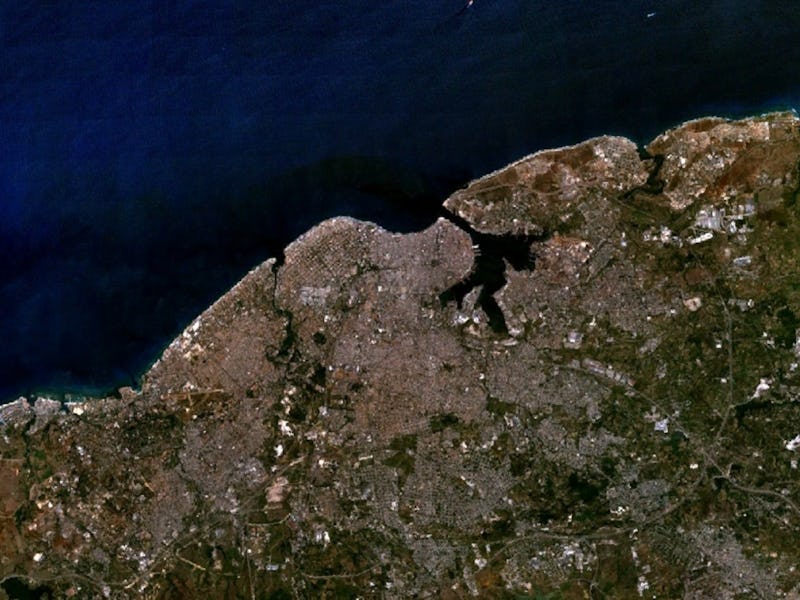The Future of Havana: Architecture as Ticking Time Bomb
The "Paris of the Caribbean" is beautiful. Too bad it's running out of water and drowning in its own shit.

Now that the Obama administration is working to reestablish diplomatic relations with the largest island nation in the Caribbean, there’s a lot of optimism that Cuba’s capital city, Havana, and its population of over two million could see prosperity over the relatively short term. But Cuba watchers and an increasing number of people on the ground are learning that you can’t build a future without stabilizing the past.
One of the city’s biggest draws is its architecture, which has a distinct European feel. “Some people have called it ‘the Paris of the Caribbean,’” says John Pilling, an architect based in Boston who has visited the country a few times. “It’s a handsome city, even in its state of disrepair.”
Disrepair is the right word. The city, designated World Heritage Site by UNESCO, is currently in very poor shape with crumbling infrastructure, terrible roads, and crumbling facades. Cuba needs money, and it needs it fast. The problem, explains Joe Scarpaci, a professor of marketing at West Liberty University in West Virginia, who has written extensively about Cuba and traveled to the country 74 times, is that Cuba is not a safe place to invest. “It’s always at the bottom five or six in terms of places for safe investment,” he says. Communism and capitalism have never been good bedfellows.
When Fidel Castro took over the country in 1959, the Soviet Union quickly became Cuba’s primary benefactor. For decades, Castro’s friends in Moscow kept the country afloat, even in the midst of failed domestic fiscal policies. Then, in 1991, the Soviet Union collapsed. According to Scarpaci, Cuba “jumped on the sustainability bandwagon because they didn’t have anywhere else to go.” Urban farming took off in Havana and other major cities and allowed the country to withstand the effects of trade sanctions and maintain its food sovereignty.
That sustainability didn’t really translate to other aspects of life. There are some wind and solar energy systems, but they don’t operate at scale. And the Castros never really invested in bringing infrastructure up to date, which is why the future of this country mired in the past is, at best, the present.
Havana’s water infrastructure is the worst of it. Scarpaci says 55 percent of Havana’s pipes and water systems are leaking. An aqueduct built in 1983 was originally designed to accommodate a city 600,000 — not today’s 2.2 million. “Havana is on the verge of getting salt water intrusion into the two aquifers of the city,” he says. “The water pressure in the water mains are very low. That means unless you’re close to a pumping station and you turn a spigot on, not a lot comes out. So every day hundreds of water trucks go out through the city, burning diesel fuel. They turn on their generators, they run a hose, pump water up to the roof. You can’t say it’s anywhere near sustainable.”
And of course, the problems with the infrastructure engender poor water quality, causing disease outbreaks like cholera to pop up far too frequently. Not one single primary treatment facility exists in Havana, Scarpaci says. “All the poop goes out to the bay, or it’s shifted and pumped outside the eastern side of the city.”
The government is now working to play catch up. The have all the talent in the world when it comes to the right kinds of engineers, urban designers, and other innovators who can come up with solutions — and in a way that preserves the beloved history of the city. Gina Rey, a professor of architecture at the University of Havana, has done a tremendous amount of work to lay out plans for how Havana can upgrade its spaces and services while adhering to a sustainable standards. In 2011, Julio César Pérez Hernández, a practicing Cuban architect, showed of his Havana Master Plan proposal, which would reinvigorate the waterfront with design concepts inspired by other cities around the world while providing desperate upgrades to the local infrastructure.
The problem is, Cuba just doesn’t have the money to turn those things from concept to reality. At least, perhaps, it’s not focusing its time and resources where it needs to. There are signs that when given the opportunity, Havana can fix its problems. Pilling cites a couple of projects as examples, like the rebuilding sewage pumping station on enclosure of the Havana waterfront, a new commercial building being converted into a 12-story hotel, and other contemporary works.
But these tend to be focused on helping to bolster the city’s tourism industry — not necessarily its residents who already live there and struggle with day-to-day inadequacies. The new hotels and condos do spur developers to improve the water lines in the neighborhoods, but that’s just about the only factor. The city’s populace is still left to deal with buildings that are withering away, in crowded neighborhoods only getting more crowded. And this worsens the standard of living for Cubans in more ways than one. “The urban fabric impacts the social and psychological fabrics,” says Scarpaci.
How exactly Havana is going to get the money it needs remains to be seen. Although normalizing U.S.-Cuba relations could open up many doors for American businesses to make their way over the 90 miles of water and begin pouring money into the region, the country’s leaders will need to act responsibly to make sure that money is being used for the right things. Havana was already the stage of one revolution nearly half a century ago. It may need to host another one soon. Hopefully this one is in the right direction.